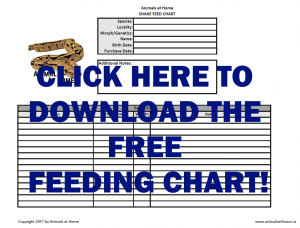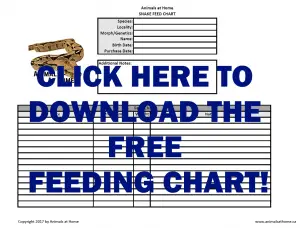Are you a proud owner of a beautiful boa constrictor? Feeding your pet can be a daunting task, especially if you are new to the world of snake care. But fear not, because this ultimate boa feeding guide has got you covered with everything you need to know to keep your snake happy and healthy.
From understanding the feeding habits of wild boas to choosing the right prey size for your pet, this guide will provide you with all the essential information you need to become a pro at feeding your boa. So sit back, relax, and get ready to learn all about the fascinating world of boa constrictor feeding!
The Ultimate Boa Feeding Guide: Everything You Need to Know
Feeding your boa properly is essential for its health and well-being. Boas are carnivores, so they require a diet of whole prey items such as mice, rats, and birds. The frequency of feeding depends on the age and size of the boa, but generally, young boas should be fed every 5-7 days while adults can be fed every 10-14 days. It’s important to monitor their weight and adjust feeding accordingly. Always offer appropriately sized prey, and never feed live prey as it can be dangerous for the snake.

The Ultimate Boa Feeding Guide: Everything You Need to Know
Boa constrictors are one of the most popular pet snakes in the world. They are known for their size, docile nature, and unique appearance. As with any pet, taking care of a boa constrictor requires a lot of work, but one of the most important aspects of boa care is feeding. In this guide, we will cover everything you need to know about feeding your boa constrictor.
What Do Boa Constrictors Eat?
Boa constrictors are carnivores, which means they eat meat. In the wild, they eat a variety of prey, including rodents, birds, lizards, and even other snakes. In captivity, frozen-thawed rodents are the most common food source for boas. You can purchase frozen rodents from pet stores or online.
It’s important to feed your boa appropriately sized prey. Feeding prey that is too small can lead to malnourishment, while feeding prey that is too large can lead to regurgitation or other health issues. As a general rule of thumb, the prey should be about the same size as the thickest part of your boa’s body.
Feeding Frequency
Young boas should be fed more frequently than adults. A hatchling boa should be fed once every 5-7 days, while an adult can be fed once every 2-3 weeks. It’s important not to overfeed your boa, as obesity can lead to health problems.
How to Feed Your Boa
When feeding your boa, it’s important to use tongs or forceps to avoid being mistaken for food. Boas have poor eyesight and rely on their sense of smell to find food, so it’s important to thaw the prey in warm water before feeding to increase the scent.
Hold the prey with the tongs and offer it to your boa. Boas are ambush predators, so they may not immediately strike at the prey. If your boa does not eat the prey within an hour, remove it from the enclosure to avoid contamination.
Water and Hydration
Boas require a clean source of water at all times. They may soak in their water bowl to aid in shedding, so it’s important to keep the water bowl large enough for the snake. Boas also need a humid environment, so misting the enclosure daily can help maintain the proper humidity levels.
The Benefits of Feeding Frozen Prey
Feeding your boa frozen-thawed prey has many benefits. Frozen rodents are more convenient than live prey, as they can be stored in the freezer and thawed as needed. Frozen prey is also safer for your boa, as live prey can bite or injure the snake during feeding.
Feeding vs. Free Roaming
Some boa owners choose to allow their snakes to roam freely in their homes, feeding them live prey as they would in the wild. However, this is not recommended for several reasons. Live prey can injure your boa, and the snake may become lost or stuck in a dangerous area of your home.
Regurgitation
Regurgitation is a common health issue in boas. It occurs when the snake regurgitates its food due to stress, improper feeding, or illness. If your boa regurgitates its food, it’s important to wait at least a week before attempting to feed again.
Feeding During Shedding
Boas may refuse to eat during shedding, as their vision and appetite may be impaired. It’s important not to force-feed your boa during shedding, as this can cause stress and lead to regurgitation.
Feeding During Pregnancy
Boas can become pregnant and give birth to live young. During pregnancy, it’s important to feed your boa appropriately sized prey to ensure proper nutrition for both the mother and the developing embryos.
Conclusion
Feeding your boa constrictor is an important part of keeping them healthy and happy. By following the guidelines outlined in this guide, you can ensure that your boa is getting the proper nutrition and care it needs. Remember to always consult with a veterinarian or experienced reptile keeper if you have any questions or concerns about feeding your boa.
Frequently Asked Questions
Here are some common questions and answers regarding the Ultimate Boa Feeding Guide:
What is the Ultimate Boa Feeding Guide?
The Ultimate Boa Feeding Guide is a comprehensive guide that provides everything you need to know about feeding your boa. It covers topics like feeding frequency, prey selection, feeding techniques, and more. The guide is designed to help you ensure that your boa stays healthy and well-fed.
Whether you’re a new boa owner or an experienced reptile enthusiast, the Ultimate Boa Feeding Guide is an essential resource that can help you provide your boa with the best possible care. With detailed information on every aspect of feeding your boa, this guide is a must-read for anyone who wants to keep their snake healthy and happy.
How often should I feed my boa?
The frequency of feeding your boa will depend on its age, size, and overall health. Young boas require more frequent feedings than adults, and larger boas may need to be fed less often than smaller ones. As a general rule, most boas should be fed once every 7-10 days.
It’s important to remember that overfeeding can be just as harmful as underfeeding. Feeding your boa too frequently or offering prey that is too large can lead to obesity, health problems, and digestive issues. Be sure to follow the feeding guidelines in the Ultimate Boa Feeding Guide to ensure that your snake stays healthy and well-fed.
What types of prey are best for my boa?
The best types of prey for your boa will depend on its size and dietary needs. In general, boas should be fed prey that is appropriately sized for their body. For young boas, this may mean feeding small rodents like pinky mice or rat pups. As they grow, they may require larger prey like adult mice or small rats.
It’s important to offer prey that is nutritionally complete and free from disease or parasites. The Ultimate Boa Feeding Guide provides detailed information on selecting and preparing prey for your boa, so be sure to read through this section carefully.
Can I feed my boa live prey?
While some snake owners prefer to feed live prey, it’s generally not recommended for boas. Live prey can be dangerous for your snake, as it may injure or kill your boa during the feeding process. Additionally, live prey can carry diseases or parasites that may be harmful to your snake.
The safest and most humane way to feed your boa is to offer pre-killed prey that has been frozen and thawed. This ensures that the prey is disease-free and poses no risk to your snake. The Ultimate Boa Feeding Guide provides detailed instructions on thawing and preparing frozen prey for your snake.
What should I do if my boa refuses to eat?
It’s not uncommon for boas to refuse food from time to time. This may be due to stress, illness, or environmental factors. If your boa refuses to eat, it’s important to rule out any underlying health issues by consulting with a veterinarian.
If your boa is healthy but still refuses to eat, there are several things you can try to stimulate its appetite. These include offering a variety of prey items, warming the prey to increase its scent, and adjusting the feeding schedule. The Ultimate Boa Feeding Guide provides detailed information on troubleshooting feeding problems, so be sure to consult this resource if you’re having trouble getting your boa to eat.
In conclusion, feeding your boa constrictor is an essential part of keeping them healthy and happy. By understanding their natural diet and feeding habits, you can create a feeding schedule that works for both you and your pet. Remember to always offer the right size and type of prey, and monitor your boa’s behavior and health closely. With these tips and tricks, you can become an expert at feeding your beloved pet boa.
Feeding your boa can be a rewarding experience, but it’s important to approach it with caution and care. Always handle your snake with respect and follow proper safety procedures when feeding. With a little patience and practice, you can become confident in your ability to provide your boa with the nutrition they need to thrive.
Finally, don’t hesitate to seek advice from experienced reptile owners or a veterinarian if you have any questions or concerns about feeding your boa constrictor. By working together, we can ensure that our pet boas receive the best possible care and live long, healthy lives.


